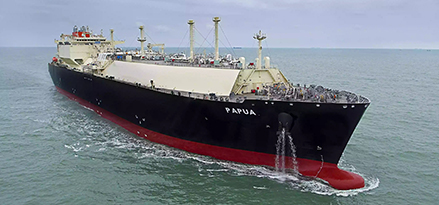
ExxonMobil and Mitsui O.S.K. Lines (MOL) successfully complete three-month bio marine fuel blend trial
The pilot project featured a bio marine fuel blend of a 0.50% sulphur residual-based fuel oil (VLSFO) blended with up to 25% waste-based fatty acid methyl esters (FAME) derived from used cooking oil methyl ester (UCOME).
Background
Mitsui O.S.K. Lines (MOL) was looking to trial a bio marine fuel blend, in line with the its evolving environmental strategy, 'MOL Group Environmental Vision'. The vessel operator therefore discussed with ExxonMobil as a potential supplier of an engine-ready alternative to conventional marine fuel formulations.
ExxonMobil offered to bunker a bio marine fuel blend of a 0.50% sulphur residual-based fuel (VLSFO) blended with up to 25% waste-based fatty acid methyl esters (FAME) derived from used cooking oil methyl ester (UCOME).
The resulting ‘drop-in’ blend met the requirements of ISO 8217:2017* with the exception of the FAME component. The FAME component complied with EN 14214**. The bio-component has been certified with the International Sustainability and Carbon Certification (ISCC) organisation.
Process
The bio marine fuel blend underwent a range of compatibility tests before it was successfully bunkered in Singapore for Papua New Guinea Liquefied Natural Gas Global Company LDC (PNG LNG) chartered vessel PAPUA. The receiving vessel, PAPUA, has two MAN ES 6S70ME-C8.2 propulsion engines, which enabled the crew to monitor the new fuel blend’s performance alongside a conventional marine fuel oil under near identical operating conditions. The four Daihatsu 8DC-32E auxiliary engines were similarly divided up for side-by-side comparisons of the two fuels.
During the three-month pilot project, the propulsion and auxiliary engines using the bio marine fuel blend were continually monitored in different navigational conditions. The previously used cylinder lubricants, Mobilgard™ 540 and Mobilgard™ 570, were successfully retained throughout the trial.
Outcome
MOL reported that the trial was a success, both in terms of achieving an estimated 20% reduced lifecycle CO2 emissions compared to conventional marine fuel oil, according to MOL analysis,1 and reliable engine operations. NOx and particulate emissions were also within accepted operating parameters. The increase in fuel consumption for the engines using the bio marine fuel was negligible2.
Both ExxonMobil and MOL regard bio marine fuel blends to be well-positioned to help meet the need for quality fuels that are both reliable and ISO compliant and can help operators reduce their lifecycle GHG emissions3.
ExxonMobil has several projects and activities progressing for the advancement of lower-emission fuels, and has a goal to supply 200,000 barrels per day of lower-emission fuels by 2030.
*ISO 8217:2017(en), Petroleum products — Fuels (class F) — Specifications of marine fuels.
**EN 14214, Liquid petroleum products — Fatty acid methyl esters (FAME) for use in diesel engines and heating applications — Requirements and test methods.
Exxon Mobil Corporation has numerous affiliates, many with names that include ExxonMobil, Exxon, Esso and Mobil. For convenience and simplicity in this article, those terms and terms like corporation, company, our, we and its are sometimes used as abbreviated references to specific affiliates or affiliate groups. Abbreviated references describing global or regional operational organizations and global or regional business lines are also sometimes used for convenience and simplicity. Nothing contained herein is intended to override the corporate separateness of affiliated companies.
1CO2 emission reduction estimate calculated in accordance with the IMO INTERIM GUIDANCE ON THE USE OF BIOFUELS UNDER REGULATIONS 26, 27 AND 28 OF MARPOL ANNEX VI (DCS AND CII) issued 24 July 2023 (INTERIM GUIDANCE ON THE USE OF BIOFUELS UNDER REGULATIONS 26, 27 (imo.org)) on a well-to-wake basis and using the IMO default emission factors for fossil marine fuels (MEPC 364 79 (imo.org)). Calculated estimate is specific to the batch of certified fuel used during this trial. Actual emissions results will vary based on a number of factors including equipment used, its maintenance, operating conditions and bio-blend rates and bio components used.
2 ExxonMobil makes no representation that your experience will be similar or identical to that of the customer in this testimonial. Actual results will vary depending on factors such as equipment used, its maintenance, operating conditions and fuel previously used.
3 Compared with conventional petroleum-based liquid marine fuels, calculated on an energy basis. Estimated well-to-wake GHG emissions reduction based on the default value data published in Annex V of Directive 2018/2001/EU of the European Parliament and in Annex II